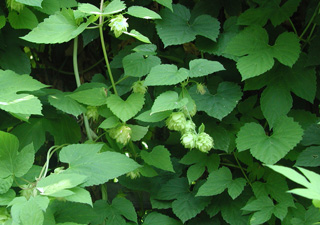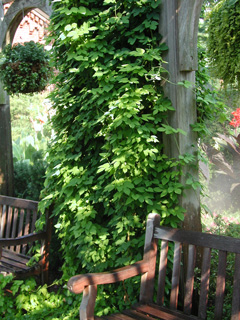Resource Library
Plant of the Week: Hops, Golden Hops
Plant of the Week
Hops, Golden Hops
Latin: Humulus lupulus ‘Aureus’
Yellow-leaved plants intrigue me because – if the shade is just right – they become beacons in the garden, casting their bright cheery color and supporting all the surrounding plants. But if the shade is off just a bit, the plants look like some anemic blob suffering from some ill-defined nutritional problem. Golden hop (Humulus lupulus ‘Aureus’) is one of the vines that got the golden color thing just right.
Hop vine is a member of the marijuana family and is native to a wide swath from Europe to Central Asia. It is a fast growing herbaceous vine that dies to the ground in the winter. The size of the clump expands laterally several feet by way of underground rhizomes. All parts of the leaves and stems are covered with tiny prickles that, while not really threatening, can cause rash and skin irritation if handled extensively.
Hops begin growth early and climb by twining the stem around some support, making several inches of growth a day. ‘Aureus’ is the original golden-leafed hops vine and it is capable of making 10 to 15 feet of growth in a single season. ‘Summer Shandy’ is a new Proven Winners introduction that is a bit more restrained, making only 6 to 10 feet of growth in a season. The leaves are bright gold in the spring but fade to light green by midsummer. The green-leafed forms used commercially in beer making are even more aggressive, growing as much as 25 feet during the season.
Hops leaves are usually three lobed with serrate margins and 3 to 4 inches in length. Plants are dioecious with only female plants typically grown. Even though they may not have their male sexual partner, female vines will set the inch-long inflated “strobiles” which appear in late summer and dangle from the vines like ear bobs.
Hops have been grown since Roman times in gardens and cultivated as an agricultural crop since at least the 8th century in Germany. Hops add a bitter bite to beer and serve as a natural preservative. Hops seem to have a mild sedative effect and are used in various homeopathic remedies. Several words have entered our lexicon due to the long history of growing and using hops in beer making. Hopping mad and hophead are examples but it is likely that the alcohol content of the brew may have more to do with the described condition than the hops used in the brew.
Hop vines are best grown in a moderately moist, highly organic soil. Plants are hardy from zones 5 through 8. In northern areas they can be grown in full sun but in more southerly climes some afternoon shade will reduce the likelihood of leaf scorch and quick loss of the golden coloration. Golden hop vine makes a nice color contrast to cover garden structures, pillars, fences, tree trunks and the like.
Because it climbs by twining its stems it will not climb a brick wall and needs a trellis support. Some prefer to cut the vine to the ground in the fall when it is first killed by frost while others leave it up and enjoy the dangling strobiles during the winter season. The strobiles, which are harvest and dried in late summer, can be used for making your own home brew.
By: Gerald Klingaman, retired
Retired Extension Horticulturist - Ornamentals
Extension News - August 8, 2014
The University of Arkansas System Division of Agriculture does not maintain lists of retail outlets where these plants can be purchased. Please check your local nursery or other retail outlets to ask about the availability of these plants for your growing area.

